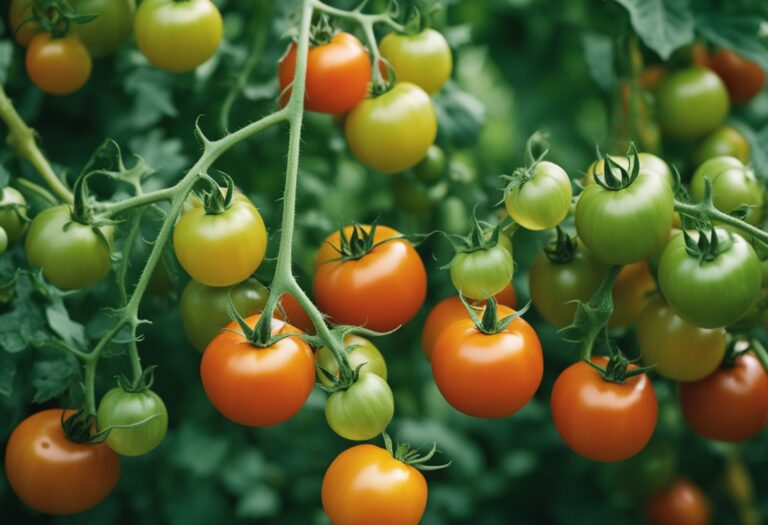Do Ladybugs Eat Tomatoes? A Friendly Guide to Ladybug Diets
Ladybugs are often considered to be a gardener’s best friend, due to their voracious appetite for pests that can damage plants. However, you may be wondering if these little insects are safe for your tomato plants. After all, tomatoes are a prized crop for many gardeners, and you wouldn’t want to accidentally harm them by introducing the wrong type of insect.
Fortunately, the answer is yes, ladybugs are safe for tomato plants. In fact, they can be quite beneficial. Ladybugs are known to feed on a variety of pests that can damage tomato plants, including aphids, mites, and whiteflies. By introducing ladybugs to your garden, you can help keep these pests under control and promote healthy tomato growth.
So if you’re looking for a natural way to protect your tomato plants from pests, consider introducing ladybugs to your garden. These little insects can be a valuable ally in your quest for a bountiful tomato harvest.
Do Ladybugs Eat Tomatoes?
Ladybugs are one of the most beloved insects in the garden, and for good reason. They are natural predators of many common garden pests, including aphids, spider mites, and whiteflies. But do ladybugs eat tomatoes?
Ladybugs’ Diet Preferences
Ladybugs are not known to eat tomatoes, but they do feed on other plants and insects that can be found in and around tomato plants. According to Master Tomato, ladybugs might be attracted to tomato plants that are infested with aphids or other small insects. Ladybugs are natural predators of these pests, so they may be drawn to the plants in search of food.
The Tomato Plant-Ladybug Relationship
While ladybugs may not eat tomatoes, they can still be beneficial to tomato plants. Ladybugs can help control aphid populations, which can damage tomato plants by sucking sap from the leaves and stems. In addition to eating aphids, ladybugs also feed on other small insects that can be harmful to tomato plants, such as spider mites and whiteflies.
Overall, ladybugs can be a valuable addition to your garden if you are looking for a natural way to control pests. While they may not eat tomatoes directly, they can help protect your tomato plants by eating other insects that can cause damage.
Benefits of Ladybugs for Tomato Plants
If you are a tomato gardener, you know that pests can be a major issue. Fortunately, ladybugs are a natural and effective way to control pests on your tomato plants. Here are some benefits of ladybugs for tomato plants:
Natural Pest Control
Ladybugs are known for their voracious appetite for pests, especially aphids and spider mites. In fact, a single ladybug can consume up to 5,000 aphids in its lifetime! By releasing ladybugs in your tomato garden, you can reduce and even eliminate pest infestations without the use of harmful pesticides.
Pollination Assistance
In addition to controlling pests, ladybugs can also help with pollination. While they are not as efficient as bees, ladybugs can still help to pollinate your tomato plants by moving pollen from one flower to another.
Plant Health Indicators
Believe it or not, ladybugs can also serve as indicators of plant health. If you notice a lot of ladybugs in your garden, it may be a sign that your plants are healthy and free of pests. On the other hand, if you don’t see any ladybugs, it could be a sign that your plants are struggling and in need of some attention.
Attracting Ladybugs to Your Tomato Garden
If you want to attract ladybugs to your tomato garden, there are a few things you can do to create a suitable habitat and provide supplementary food sources for them. Here are some tips to help you attract ladybugs to your garden:
Suitable Habitat Creation
Ladybugs need a suitable habitat to live and breed. You can create a suitable habitat for ladybugs by planting a variety of flowers and plants that they like.
Some of the plants that ladybugs like include dill, fennel, cilantro, cosmos, feverfew, marigold, statice, sweet alyssum, and yarrow. Planting these flowers and plants will not only attract ladybugs but also other beneficial insects to your garden.
Supplementary Food Sources
Ladybugs feed on pests that are on our tomato plants, such as aphids, spider mites, and ants. If you see ladybugs in your garden, think of them like they are natural pest repellents and try to keep them safe.
If you don’t see them in your garden, but you find pests on your tomato plants, you can attract the ladybugs in different ways. One way to attract ladybugs is to provide them with supplementary food sources. You can do this by placing raisins, grapes, persimmons, pears, peaches, papayas, figs, dates, and bananas in your garden.
Avoiding Pesticides
Pesticides can kill ladybugs and other beneficial insects. If you want to attract ladybugs to your garden, you should avoid using pesticides.
Instead, you can use natural pest control methods such as companion planting, crop rotation, and handpicking pests. If you do need to use pesticides, use them sparingly and only when necessary.
Identifying and Supporting Ladybug Species
Ladybugs are an essential part of any garden ecosystem, and they can help keep pests like aphids and spider mites under control. In this section, we’ll cover how to identify and support common ladybug species, as well as how to create a ladybug-friendly environment in your garden.
Common Ladybug Species
There are many different species of ladybugs, each with its unique characteristics. The most common species in North America is the seven-spotted ladybug, which has red wings with seven black spots.
Other species you may encounter include the Asian lady beetle, which can vary in color from yellow to orange and has up to 19 spots, and the convergent lady beetle, which has a red body with black spots.
Creating a Ladybug-Friendly Environment
If you want to attract ladybugs to your garden, there are a few things you can do to create a ladybug-friendly environment. First, avoid using pesticides, as these can harm ladybugs and other beneficial insects. Instead, try using natural pest control methods like companion planting or introducing other beneficial insects like lacewings or praying mantises.
You can also provide a habitat for ladybugs by planting flowers that they like, such as daisies, marigolds, and yarrow. Ladybugs also need a source of water, so consider adding a shallow dish or fountain to your garden.
Finally, you can purchase ladybugs from a garden center or online retailer and release them into your garden. However, keep in mind that releasing ladybugs may not be effective if you don’t have the right environment to support them.
In summary, identifying and supporting ladybug species is an important part of maintaining a healthy garden ecosystem. By creating a ladybug-friendly environment, you can help these beneficial insects thrive and keep pests under control without the need for harmful pesticides.
Monitoring and Managing Ladybug Populations
Ladybugs are great for tomato plants as they help control pests that can damage the plants. However, it’s important to monitor and manage ladybug populations to ensure they don’t cause damage themselves. Here are a few tips on how to do that:
- Observe ladybug activity. Keep an eye on how many ladybugs are present on your tomato plants. If you notice a large number of ladybugs, it may be a sign that they are running out of food sources and may start to eat the tomato leaves or fruit.
- Provide alternate food sources. If you notice that ladybugs are starting to eat your tomato plants, consider providing them with alternate food sources such as pollen or nectar from flowers. This can help keep them from turning to your tomato plants for food.
- Use physical barriers. If you’re concerned about ladybugs damaging your tomato plants, consider using physical barriers such as row covers or netting. This can help keep ladybugs away from your plants while still allowing air and sunlight to reach them.
Remember, ladybugs are beneficial insects that can help keep your tomato plants healthy. By monitoring and managing their populations, you can ensure that they continue to help your plants without causing damage.
Troubleshooting Common Issues
Ladybug Overpopulation
If you notice that there are too many ladybugs in your garden, it could be a sign that there is an overpopulation of aphids or other small insects. Ladybugs are natural predators of these pests, so they may be drawn to your garden in search of food.
While ladybugs are beneficial insects, too many of them can cause problems. If you notice an overpopulation of ladybugs, try removing some of the pests they are feeding on. This can help balance the ecosystem in your garden.
Ladybugs and Plant Damage
Ladybugs are generally considered to be beneficial insects, but they can cause damage to plants in some cases. While ladybugs do not eat tomato plants, they may accidentally damage them while feeding on other pests. Ladybugs have strong mandibles that they use to crush and chew their prey.
If they accidentally bite into a tomato plant, they can cause small holes or tears in the leaves. While this damage is usually minor and does not harm the plant, it can be unsightly.
If you notice damage from ladybugs, try removing some of the pests they are feeding on. This can help reduce the number of ladybugs in your garden and prevent further damage.
Frequently Asked Questions
What types of plants are part of a ladybug’s diet?
Ladybugs are known to feed on a variety of plants, including herbs, flowers, and vegetables. Some of their preferred plants include dandelions, marigolds, and fennel. However, ladybugs are not known to eat tomatoes, so you don’t have to worry about them eating your tomato plants.
Can ladybugs be helpful in a vegetable garden?
Yes, ladybugs can be helpful in a vegetable garden as they are natural predators of many common garden pests, such as aphids, spider mites, and whiteflies. They can help control these pests and prevent them from damaging your plants.
What are some common foods ladybugs consume?
Ladybugs are known to feed on a variety of insects, including aphids, mites, and scale insects. They also eat other small insects like mealybugs, whiteflies, and thrips. Ladybugs also consume pollen and nectar from flowers.
Do ladybugs typically eat plant leaves?
Ladybugs do not typically eat plant leaves. They are known to feed on insects and other small invertebrates that live on plants. While they may occasionally nibble on leaves, it is not a significant part of their diet.
Is it beneficial to purchase ladybugs for pest control?
Purchasing ladybugs for pest control can be beneficial in some cases. However, it is important to note that releasing ladybugs into your garden may not always be effective. Ladybugs may fly away or die before they have a chance to control the pests in your garden.
What insects do ladybugs prey on?
Ladybugs are known to prey on a variety of insects, including aphids, mites, scale insects, mealybugs, whiteflies, and thrips. They are natural predators of these pests and can help control their populations in your garden.


